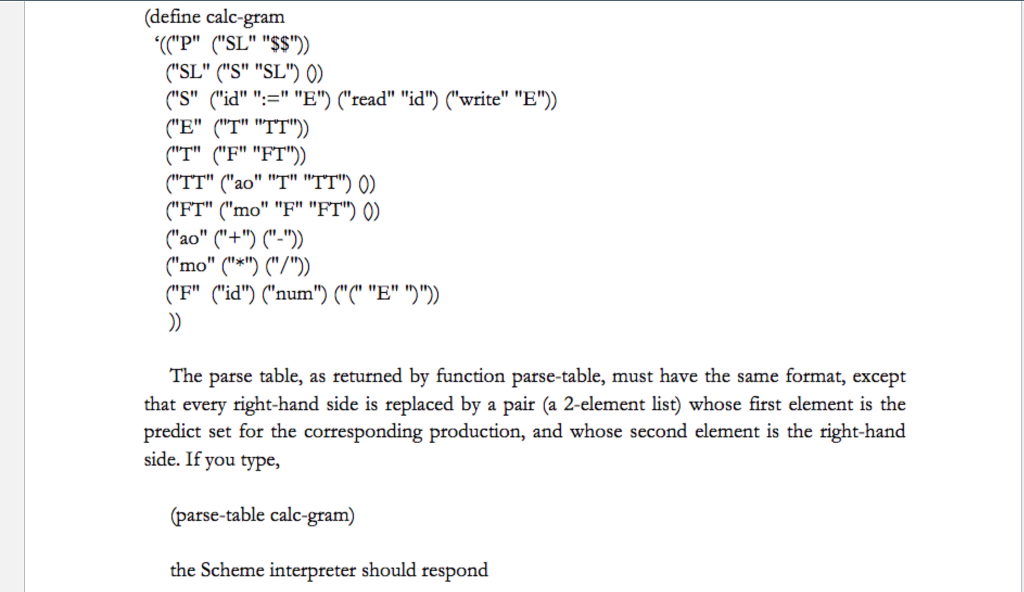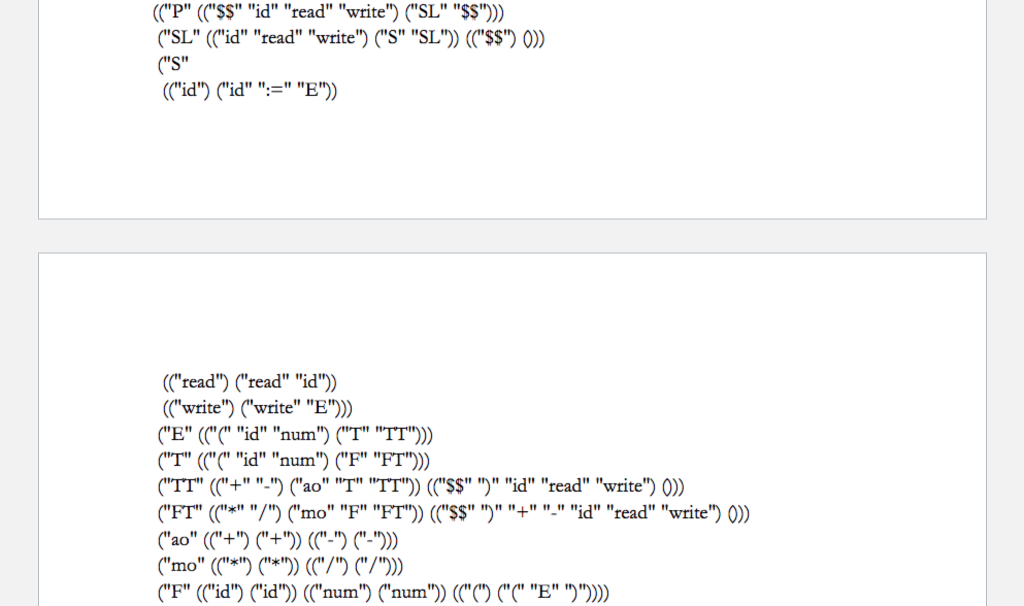Question
PLEASE DONT JUST GIVE SKELETON CODE THIS IS WHAT I KNOW SO FAR Please don't post skeleton code I need more help than that So



PLEASE DONT JUST GIVE SKELETON CODE
THIS IS WHAT I KNOW SO FAR
Please don't post skeleton code I need more help than that
So far I have this knowledge
LL Parser Generator
In syntax analysis we learned how LL(1) PREDICT sets are constructed from FIRST and FOLLOW sets. In the current project you will build, in a purely functional subset of Scheme, a parser generator that implements these constructions.
To get you started, Im providing a 300-line skeleton file. You will want to study the code in this file carefully.
The key function you are to implement is the following:
(define parse-table
(lambda (grammar)
your code here; my version is about 15 lines long,
(but it calls other functions described below)
))
The input grammar must consist of a list of lists, one per non-terminal in the grammar. The first elementof each sub-list should be the non-terminal; the remaining elements should be the right-hand sides of the productions for which that non-terminal is the left-hand side. The sub-list for the start symbol must come first. Every grammar symbol must be represented as a quoted string. As an example, here is our familiar LL(1) calculator grammar in the required format:
(define calc-gram
'(("P" ("SL" "$$"))
("SL" ("S" "SL") ())
("S" ("id" ":=" "E") ("read" "id") ("write" "E"))
("E" ("T" "TT"))
("T" ("F" "FT"))
("TT" ("ao" "T" "TT") ())
("FT" ("mo" "F" "FT") ())
("ao" ("+") ("-"))
("mo" ("*") ("/"))
("F" ("id") ("num") ("(" "E" ")"))
))
The parse table, as returned by function parse-table, must have the same format, except that every right-hand side is replaced by a pair (a 2-element list) whose first element is the predict set for the corresponding production, and whose second element is the right-hand side. If you type
(parse-table calc-gram)
the Scheme interpreter should respond
(("P" (("$$" "id" "read" "write") ("SL" "$$")))
("SL" (("id" "read" "write") ("S" "SL")) (("$$") ()))
("S"
(("id") ("id" ":=" "E"))
(("read") ("read" "id"))
(("write") ("write" "E")))
("E" (("(" "id" "num") ("T" "TT")))
("T" (("(" "id" "num") ("F" "FT")))
("TT" (("+" "-") ("ao" "T" "TT")) (("$$" ")" "id" "read" "write") ()))
("FT" (("*" "/") ("mo" "F" "FT")) (("$$" ")" "+" "-" "id" "read" "write") ()))
("ao" (("+") ("+")) (("-") ("-")))
("mo" (("*") ("*")) (("/") ("/")))
("F" (("id") ("id")) (("num") ("num")) (("(") ("(" "E" ")"))))
A parse function is provided that accepts a grammar and an input string as arguments. It calls the parse-table function and then uses it to parse the input, printing a trace of its actions as it does so, in a manner reminiscent of the Dparse output from the PL/0 compiler. You can use this function to test your code.
A possible implementation strategy
There are many ways to implement parse-table. Feel free to choose whatever strategy appeals to you. If youre not sure where to start, there is a skeleton of a few routines that may provide some guidance. These dont necessarily embody the best strategy.
This code uses two main data structures: a right context structure and a knowledge structure. A right-context function is provided to generate the former for any given
symbol B. The function returns a list of pairs. Each pair consists of a symbol A and a list of symbols such that for some , A B . As an example, if you type
(right-context "SL" calc-gram)
the Scheme interpreter should respond
(("P" ("$$")) ("SL" ()))
This tells us that SL appears on the right-hand of two productions in the grammar: one with P on the left-hand side and one with SL on the left-hand side. In the former, the portion of the right-hand side after the SL is $$. In the latter, the portion of the right-hand side after the SL is empty (that is, SL is the last thing on the right-hand side). In a similar vein, if you type
(right-context "mo" calc-gram)
the Scheme interpreter should respond
(("FT" ("F" "FT")))
This tells us there is only one production with a mo on the right-hand side. It has FT on the left-hand side, and F FT after the mo on the right-hand side.
The right-context information is useful for constructing FOLLOW sets.
Assuming you use the suggested strategy, you will need to compute the knowledge structure recursively. This structure consists of a list of 4-element sub-lists, one per non-terminal. Each
sub-list contains (1) the non -terminal itself (call it A), (2) a Boolean indicating whether we currently think that A * , (3) our current estimate of FIRST(A) {}, and (4) our current estimate of FOLLOW(A) {}. It is much easier in to keep track of separately, rather than to
include it in the FIRST and FOLLOW sets.
The function to generate the knowledge structure is
(define get-knowledge
(lambda (grammar)
;;; your code here; my version is a little under 30 lines
))
If you type
(get-knowledge calc-gram)
the interpreter should respond
(("P" #f ("$$" "id" "read" "write") ())
("SL" #t ("id" "read" "write") ("$$"))
("S" #f ("id" "read" "write") ("$$" "id" "read" "write"))
("E" #f ("(" "id" "num") ("$$" ")" "id" "read" "write"))
("T" #f ("(" "id" "num") ("$$" ")" "+" "-" "id" "read" "write"))
("TT" #t ("+" "-") ("$$" ")" "id" "read" "write"))
("FT" #t ("*" "/") ("$$" ")" "+" "-" "id" "read" "write"))
("ao" #f ("+" "-") ("(" "id" "num"))
("mo" #f ("*" "/") ("(" "id" "num"))
("F" #f ("(" "id" "num") ("$$" ")" "*" "+" "-" "/" "id" "read" "write")))
This tells us, for example, that FT generates epsilon, but F does not, and that FOLLOW(mo) = {(, id, num}.
As the base of its recursion, get-knowledge uses an initial, empty structure generated by function initial-knowledge, which is provided. At each step of the recursion the function makes use of utility routines that extract information from the current structure:
(define generates-epsilon?
(lambda (w knowledge grammar)
;;; your code here; my version is 7 lines long
))
(define first
(lambda (w knowledge grammar)
;;; your code here; my version is 10 lines long
))
(define follow
(lambda (A knowledge)
(cadddr (symbol-knowledge A knowledge))))
This is simpler than the other two functions, because it only needs
to work for individual non-terminals, not for lists of symbols.
If you work in pairs on this assignment, one possible division of labor is for one partner to
write generates-epsilon?, first, and parse-table, while the other partner writes get-
knowledge. A better strategy, however, may be to start by having one partner write generates-
epsilon? while the other writes first.
We have learned how LL(1) PREDICT sets are constructed from FIRST and FOLLOW sets. In the second part of Project 2, you will build a parser generator that implements these constructions in a purely functional subset of Scheme. The key function you are to implement is the following (lambda (grammar) " your code here; The input grammar must consist of a list of lists, one per non-terminal in the grammar. The first element of each sublist should be the non-terminal; the remaining elements should be the right- hand sides of the productions for which that non-terminal is the left-hand side. The sublist for the start symbol must come first. Every grammar symbol must be represented as a quoted string. As an example, here is our familiar LL(1) calculator grammar in the required format: We have learned how LL(1) PREDICT sets are constructed from FIRST and FOLLOW sets. In the second part of Project 2, you will build a parser generator that implements these constructions in a purely functional subset of Scheme. The key function you are to implement is the following (lambda (grammar) " your code here; The input grammar must consist of a list of lists, one per non-terminal in the grammar. The first element of each sublist should be the non-terminal; the remaining elements should be the right- hand sides of the productions for which that non-terminal is the left-hand side. The sublist for the start symbol must come first. Every grammar symbol must be represented as a quoted string. As an example, here is our familiar LL(1) calculator grammar in the required formatStep by Step Solution
There are 3 Steps involved in it
Step: 1

Get Instant Access to Expert-Tailored Solutions
See step-by-step solutions with expert insights and AI powered tools for academic success
Step: 2

Step: 3

Ace Your Homework with AI
Get the answers you need in no time with our AI-driven, step-by-step assistance
Get Started


